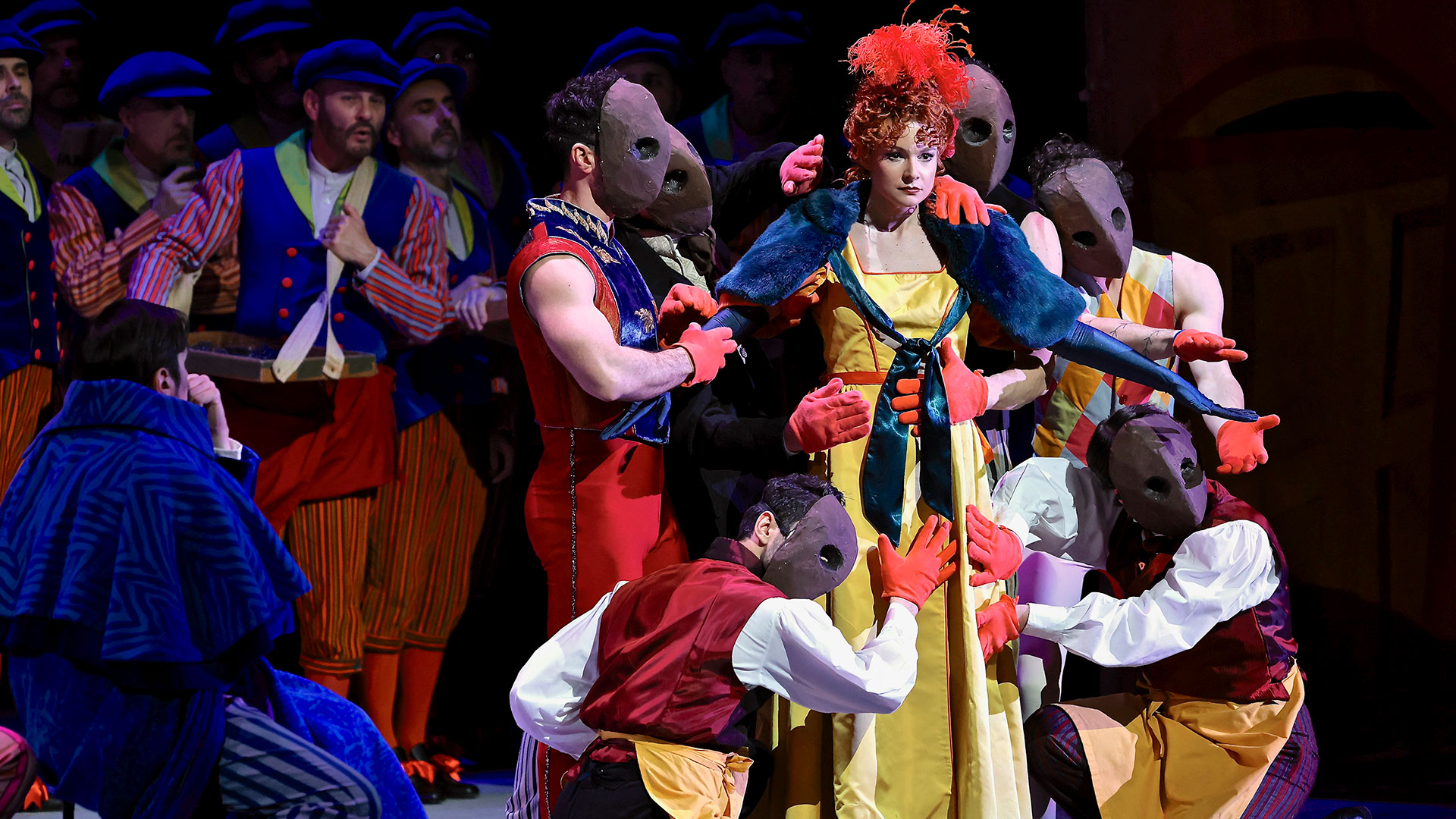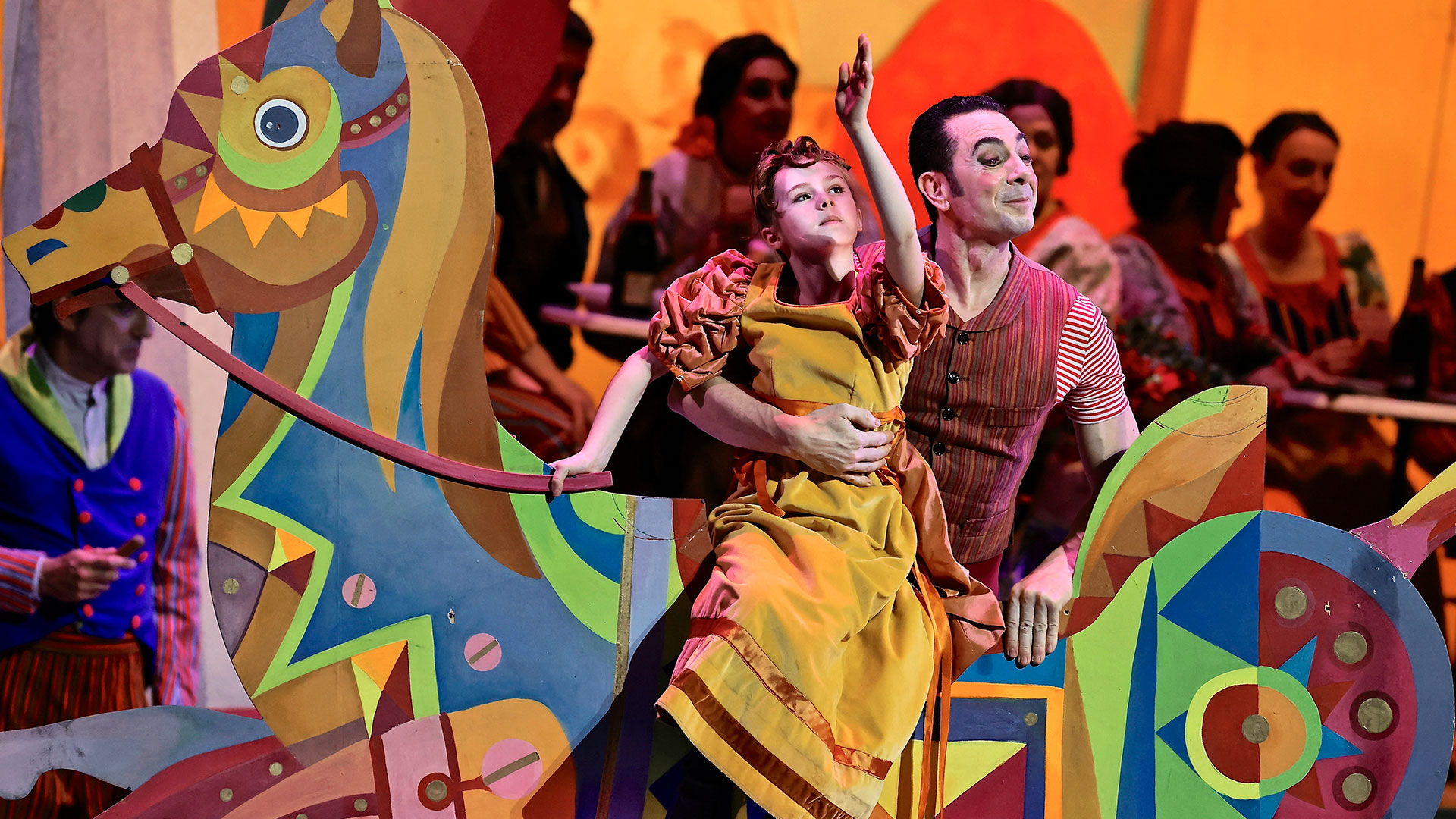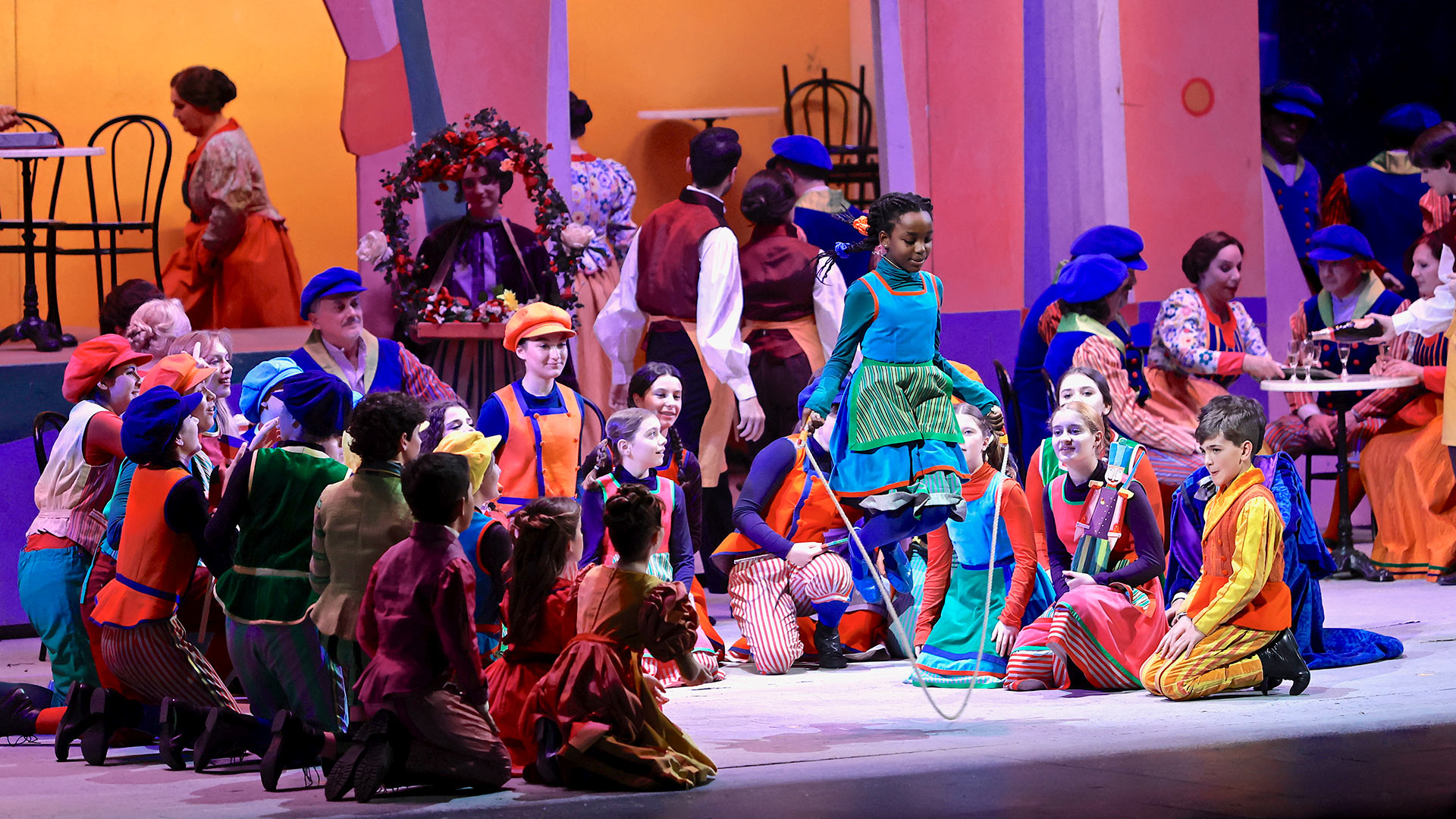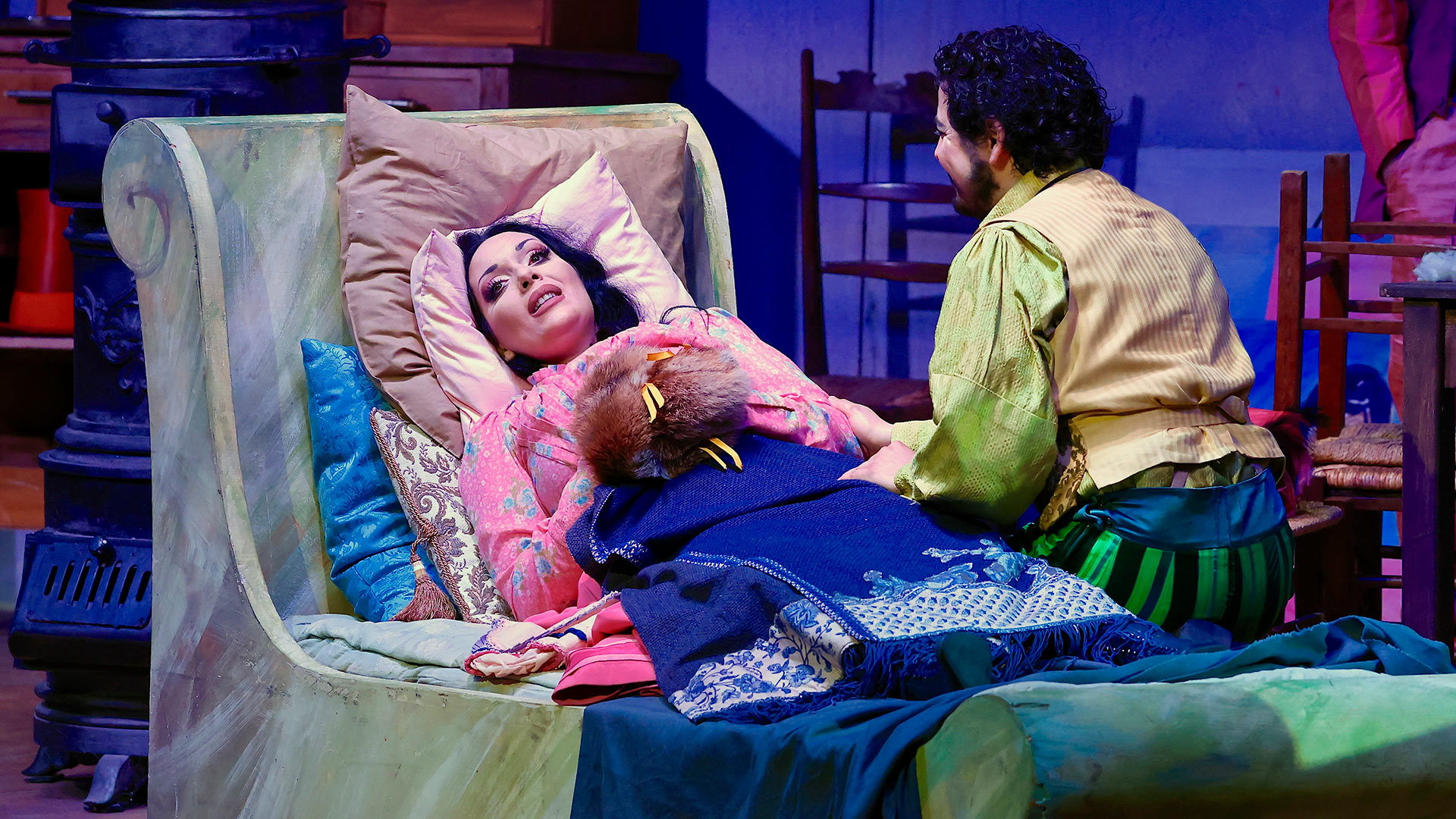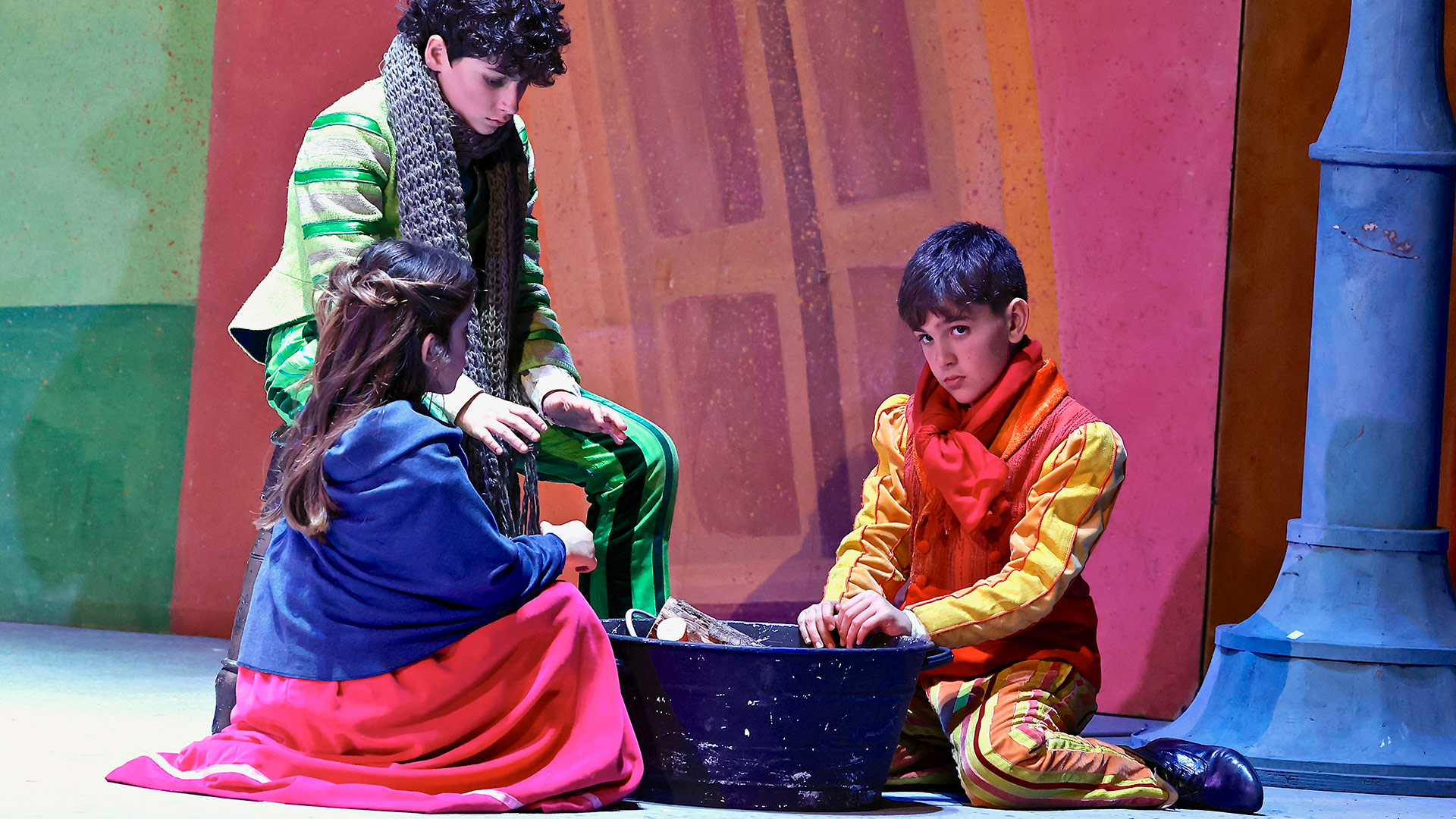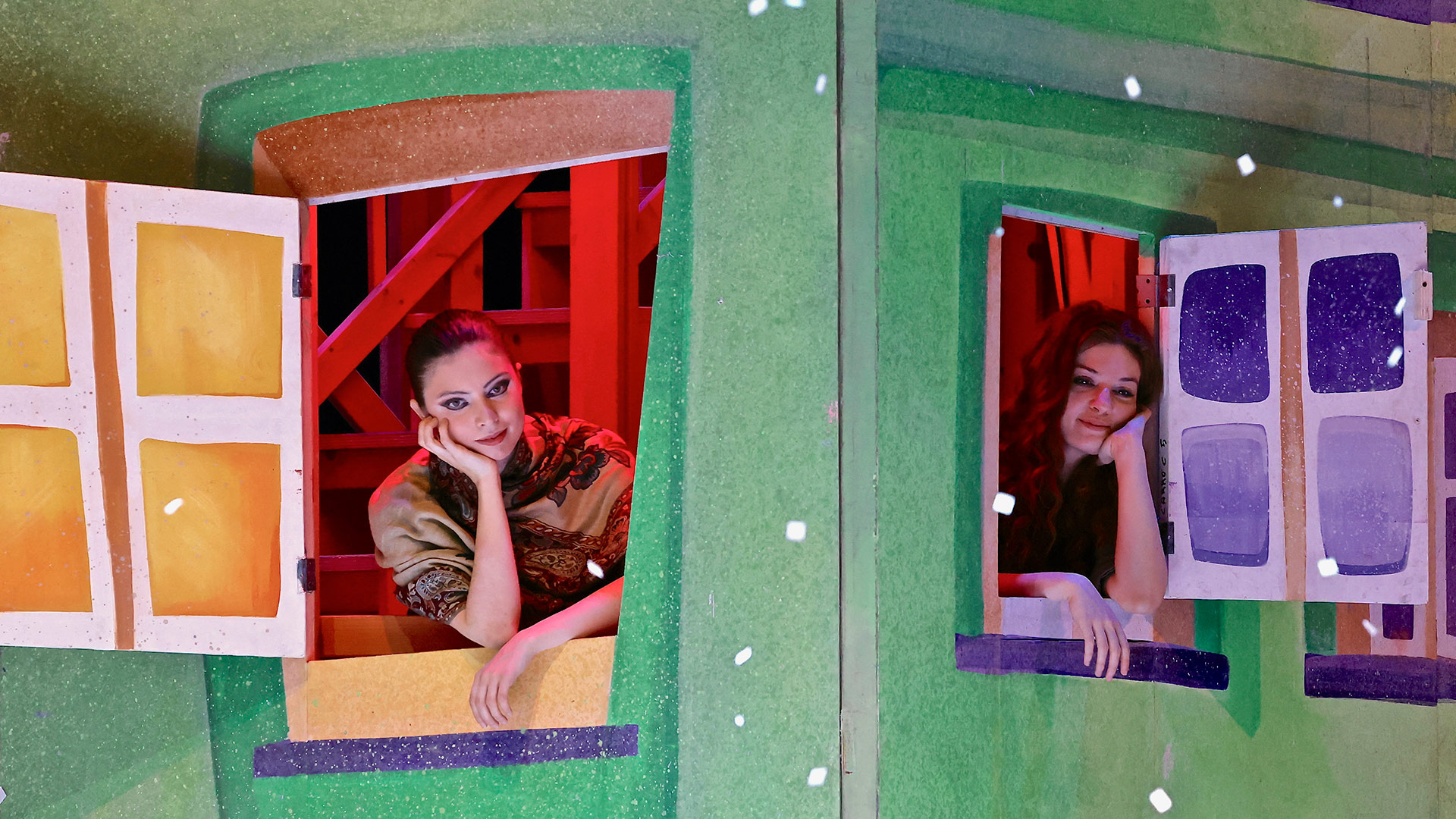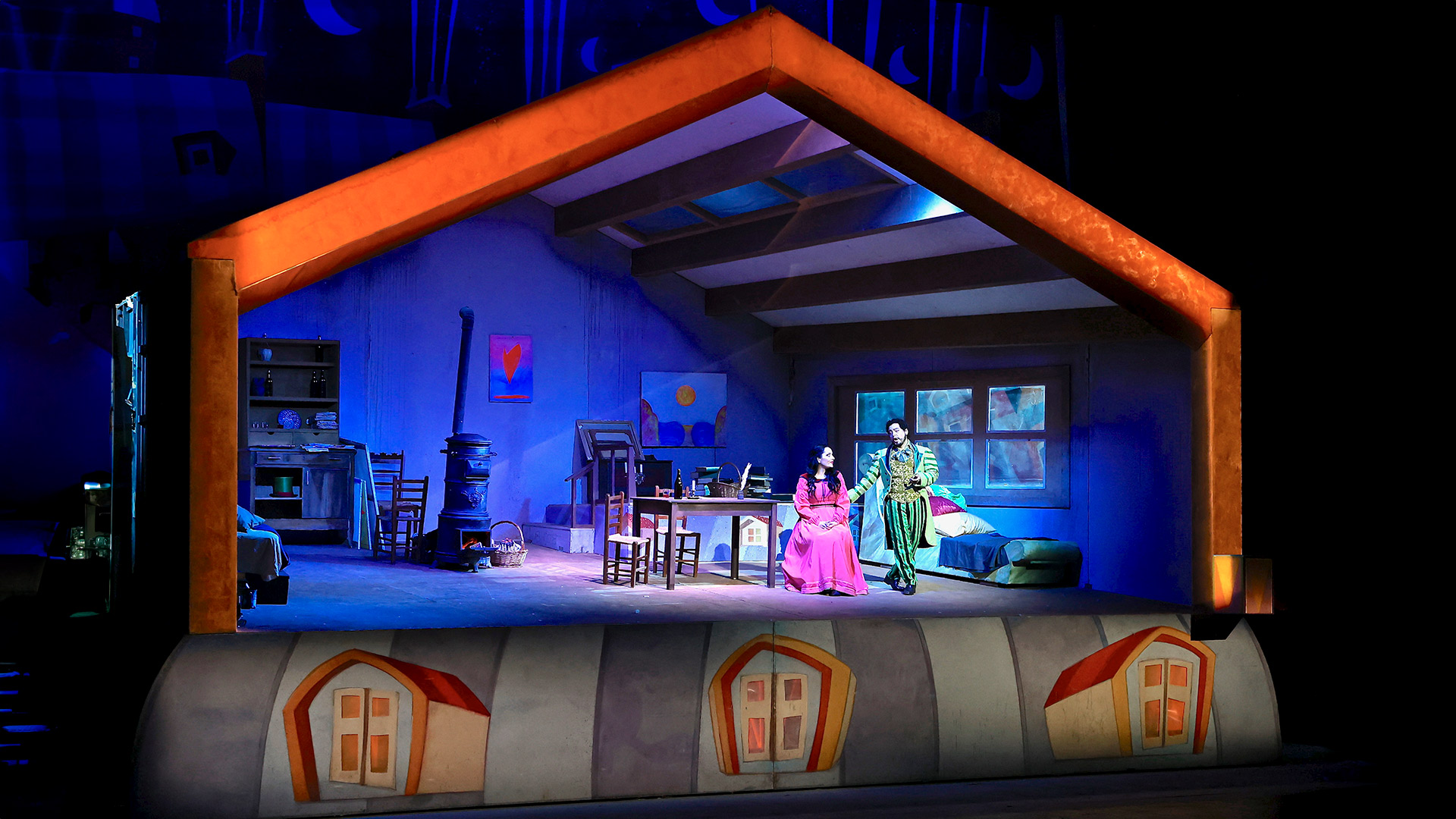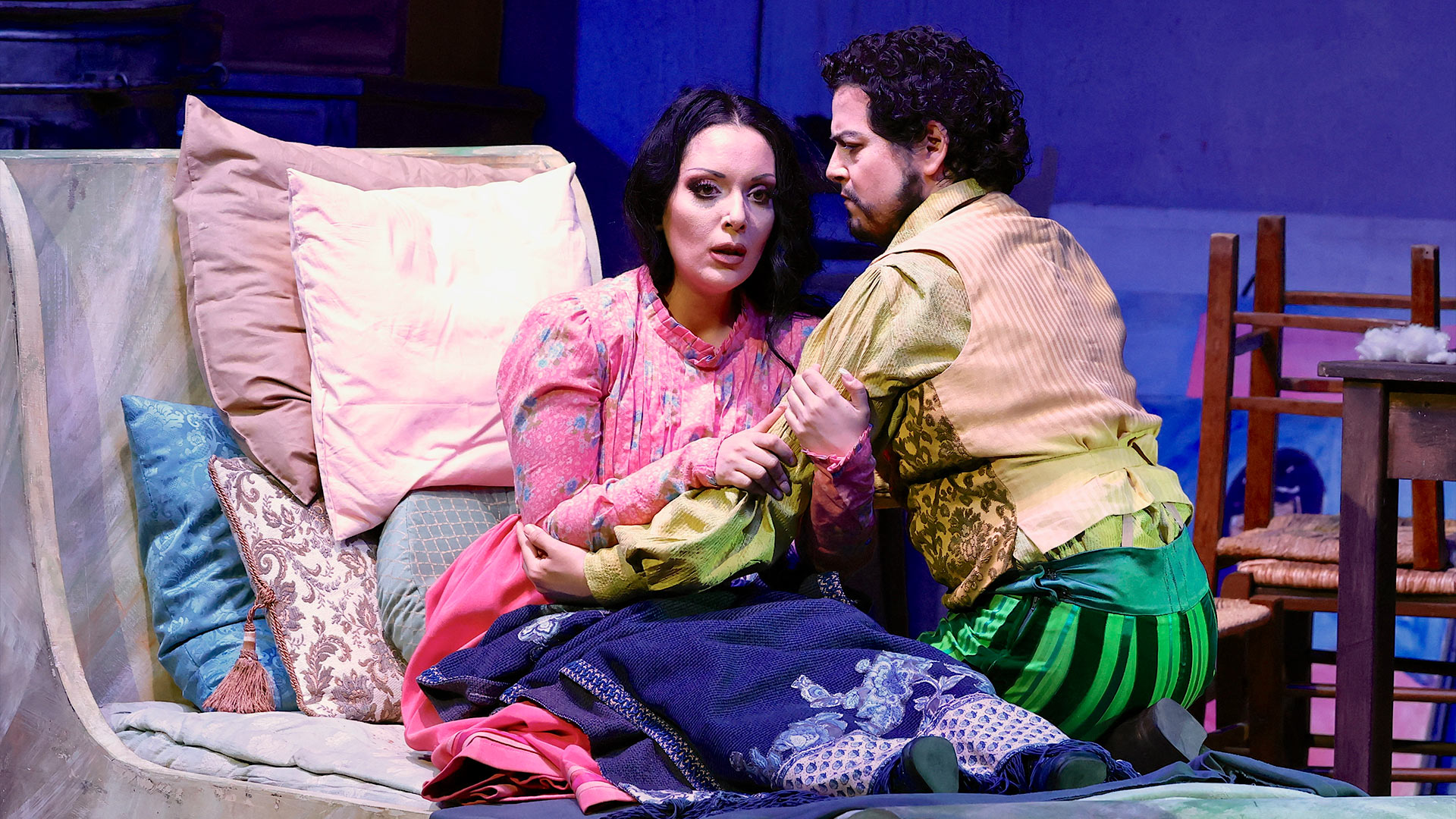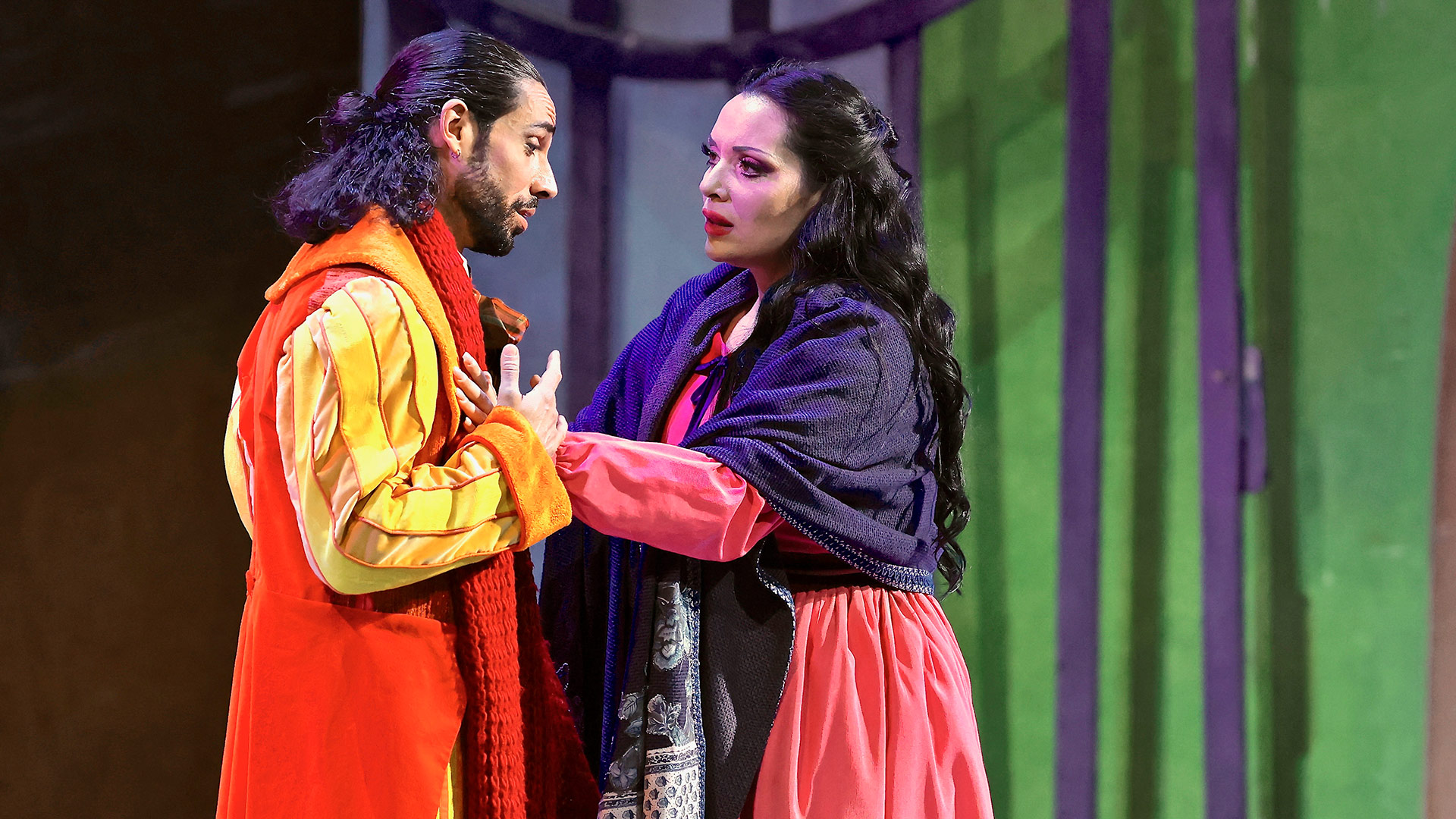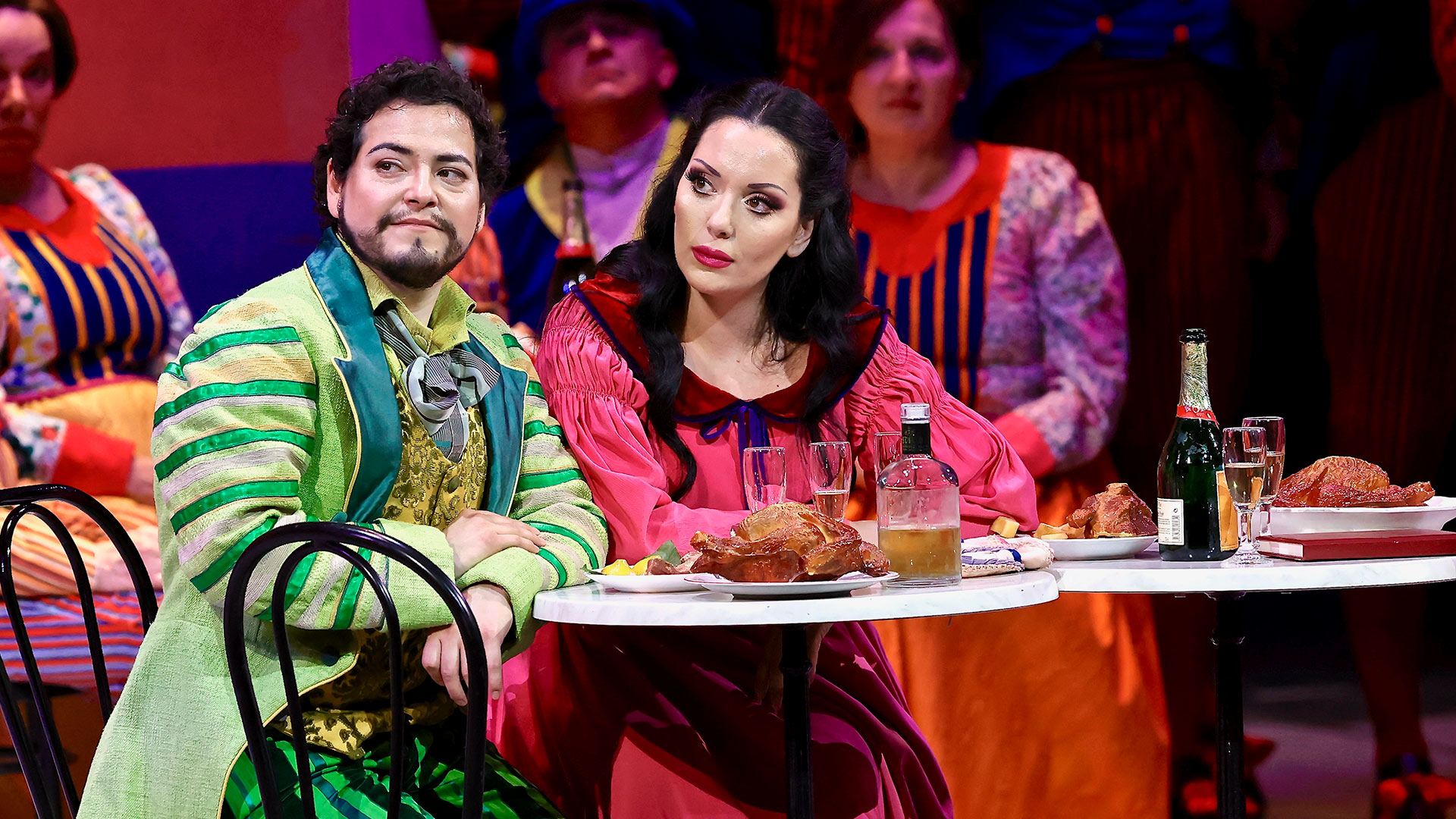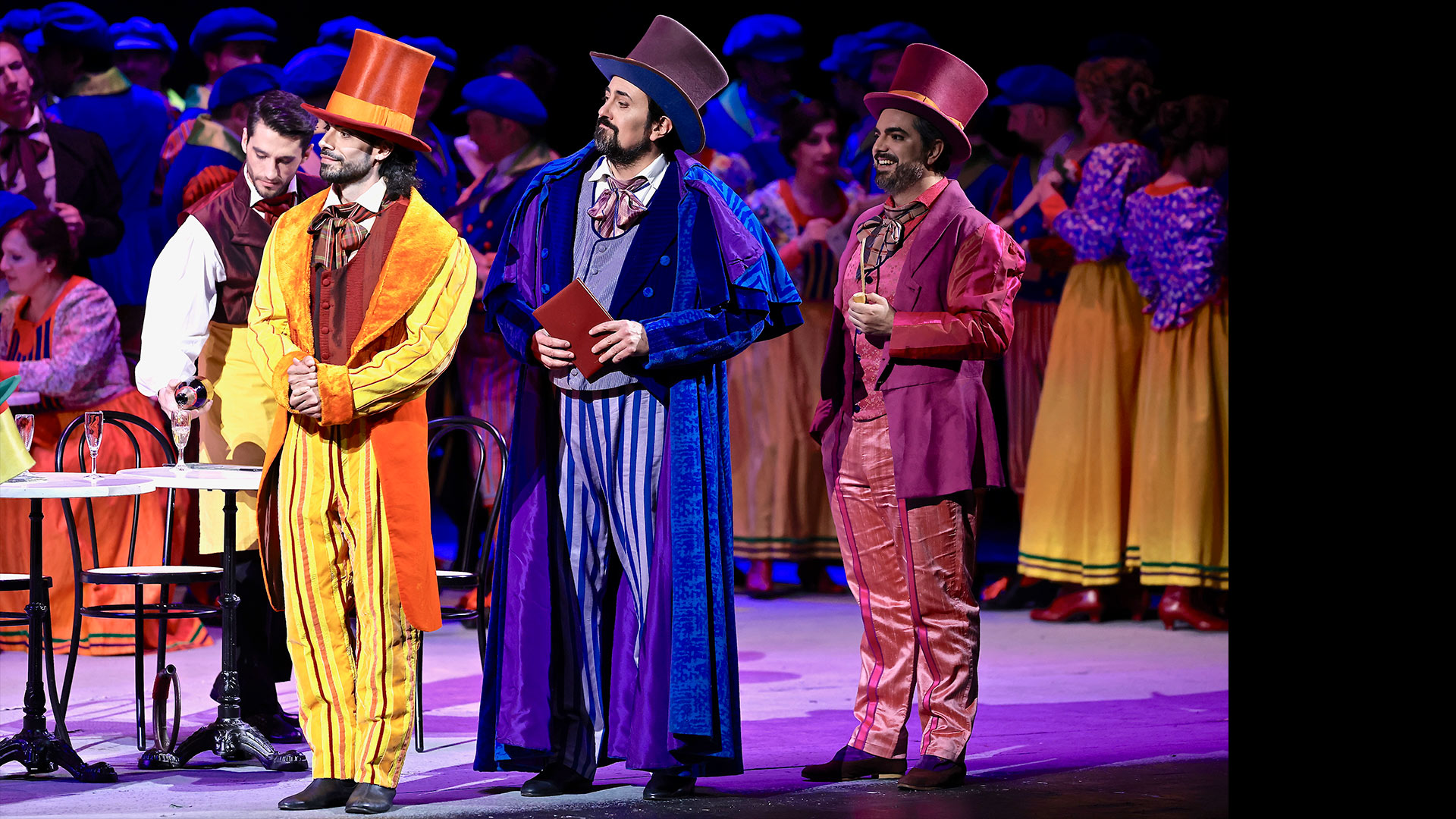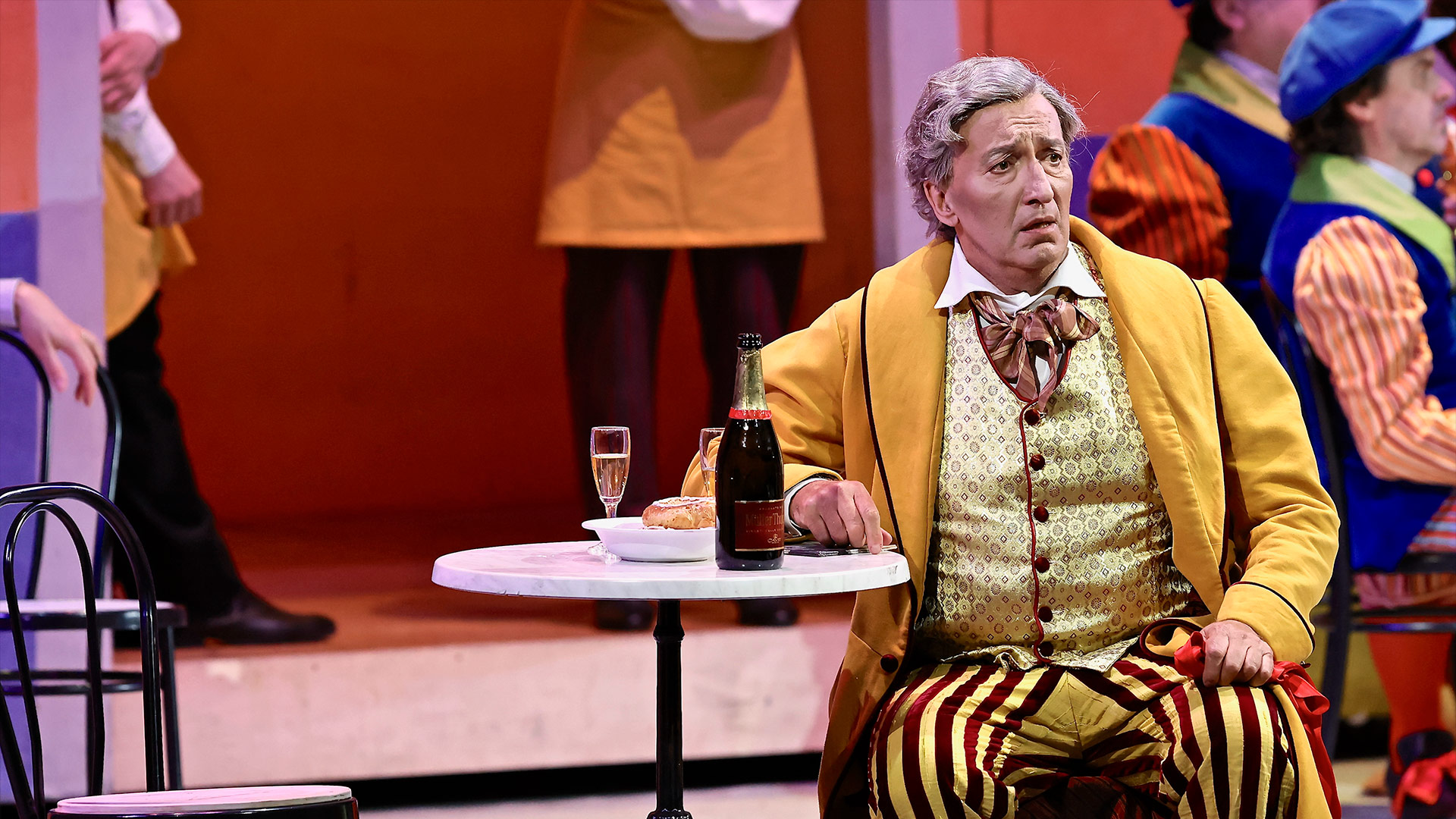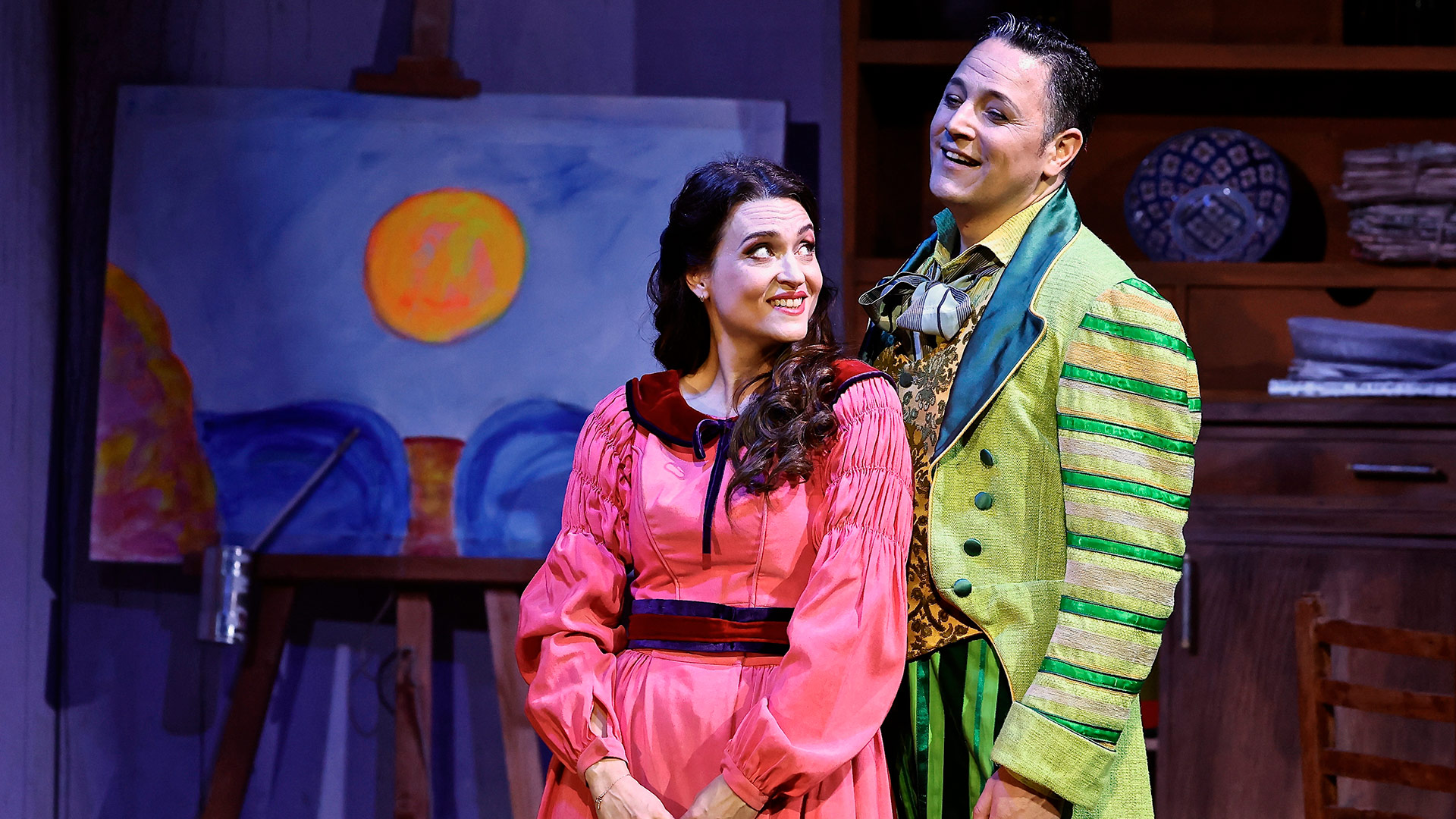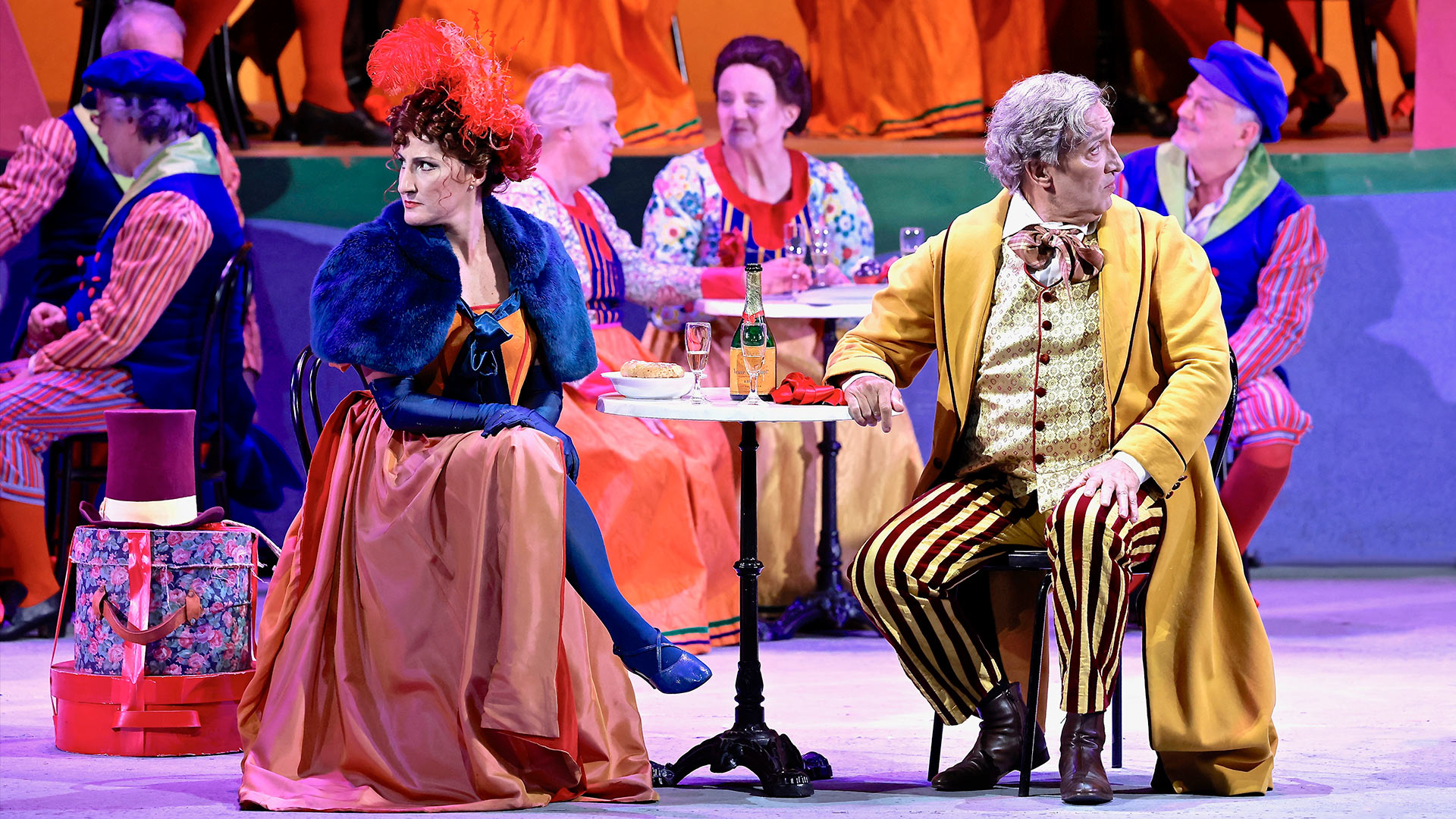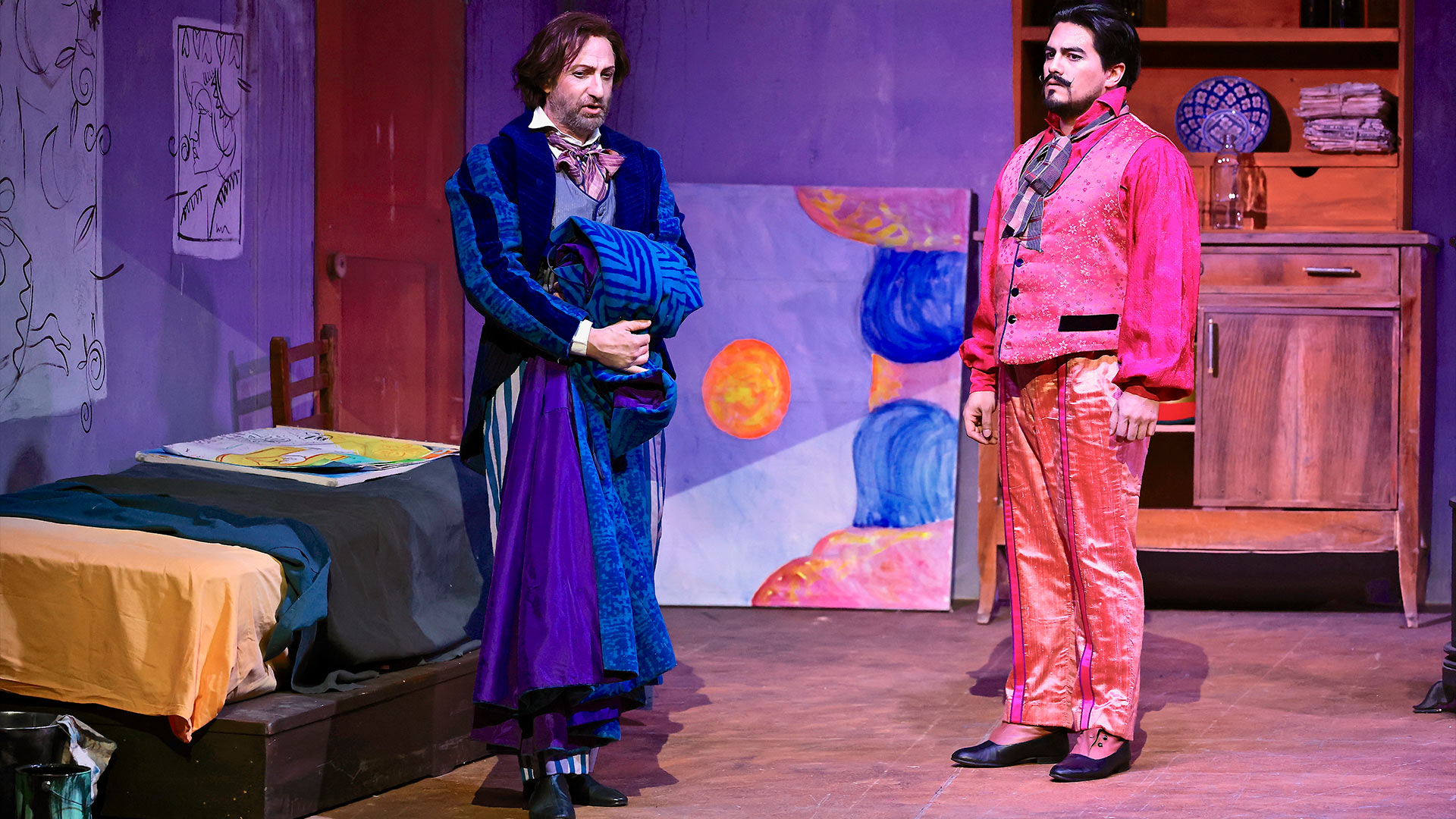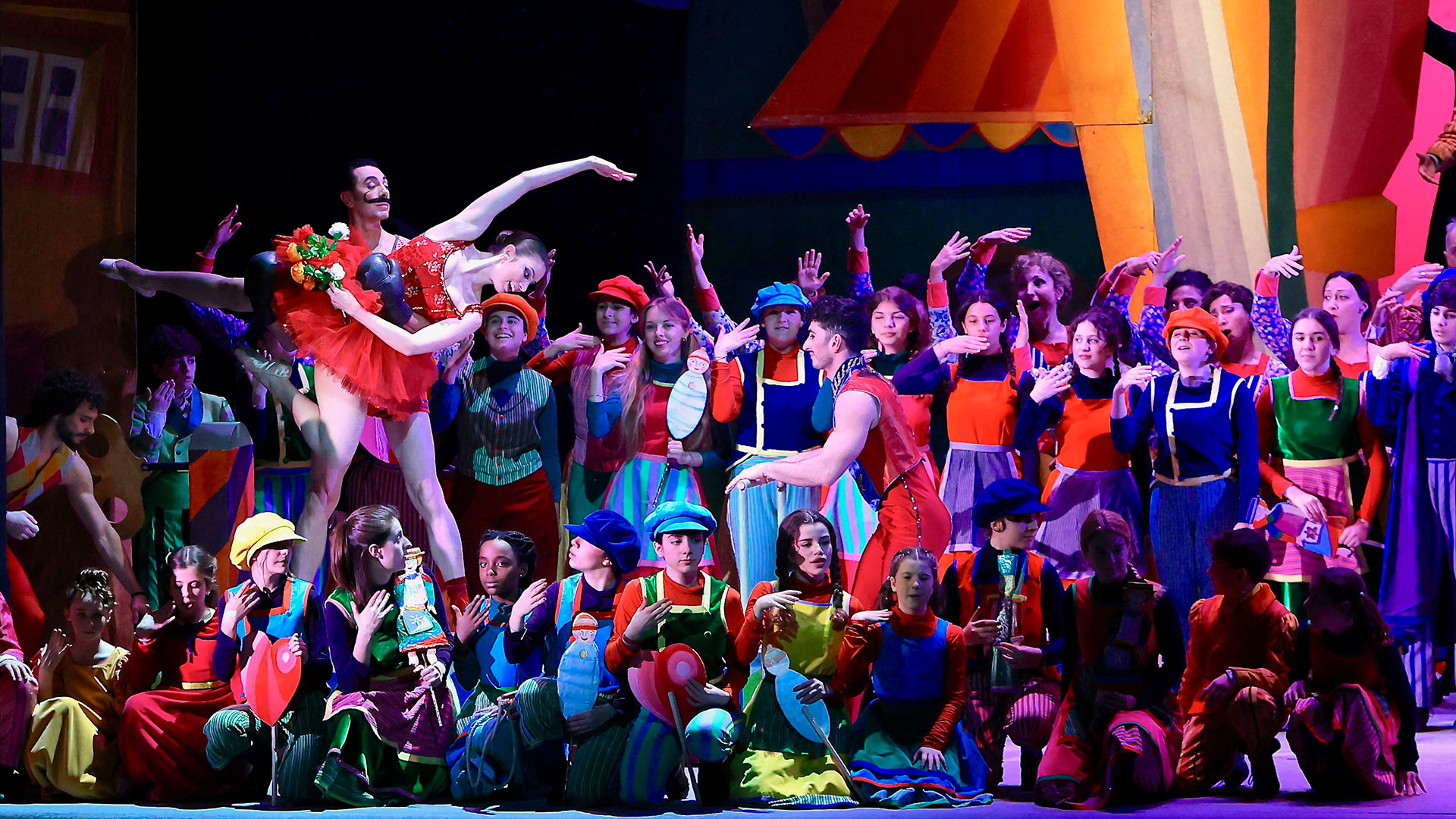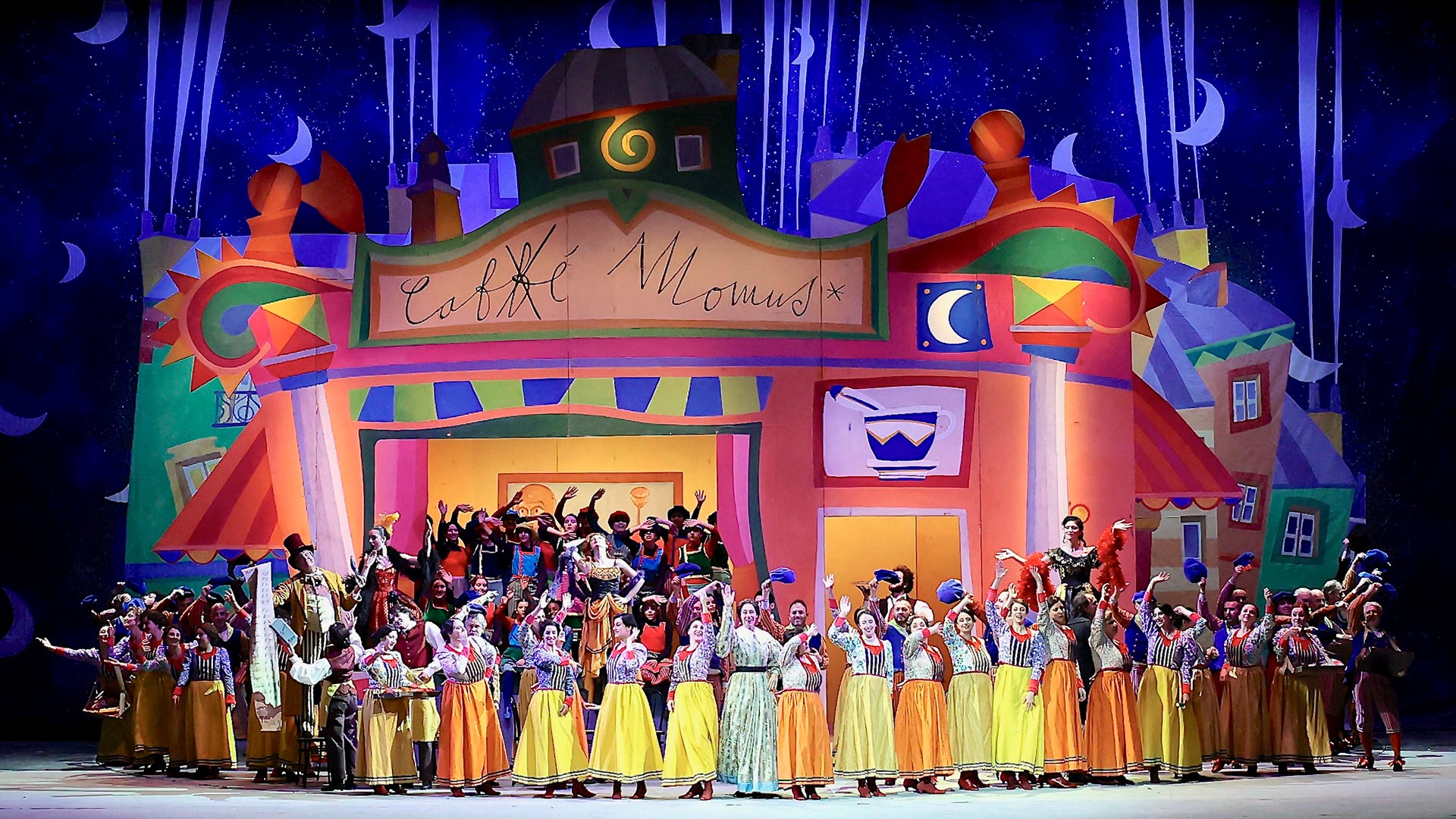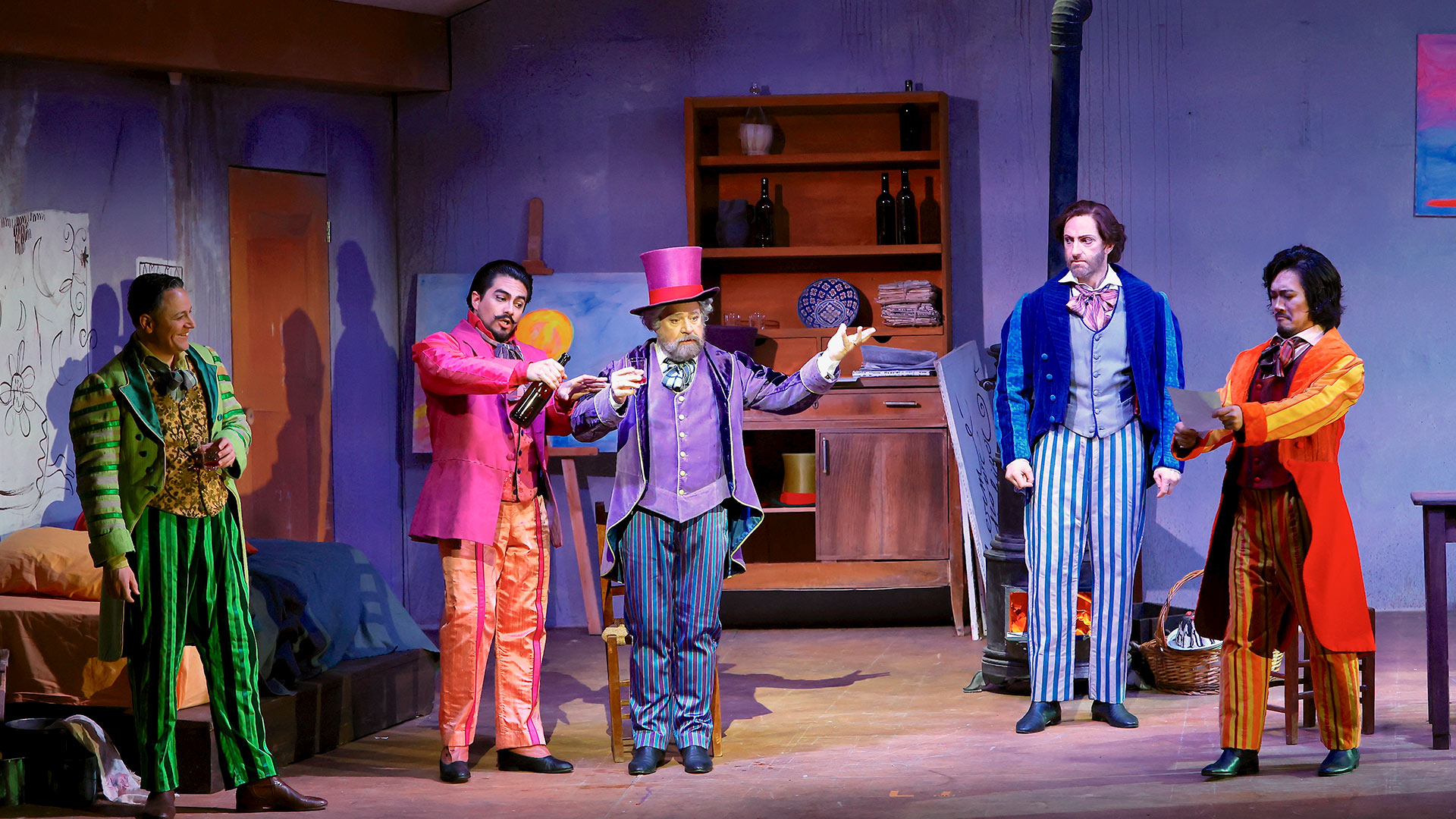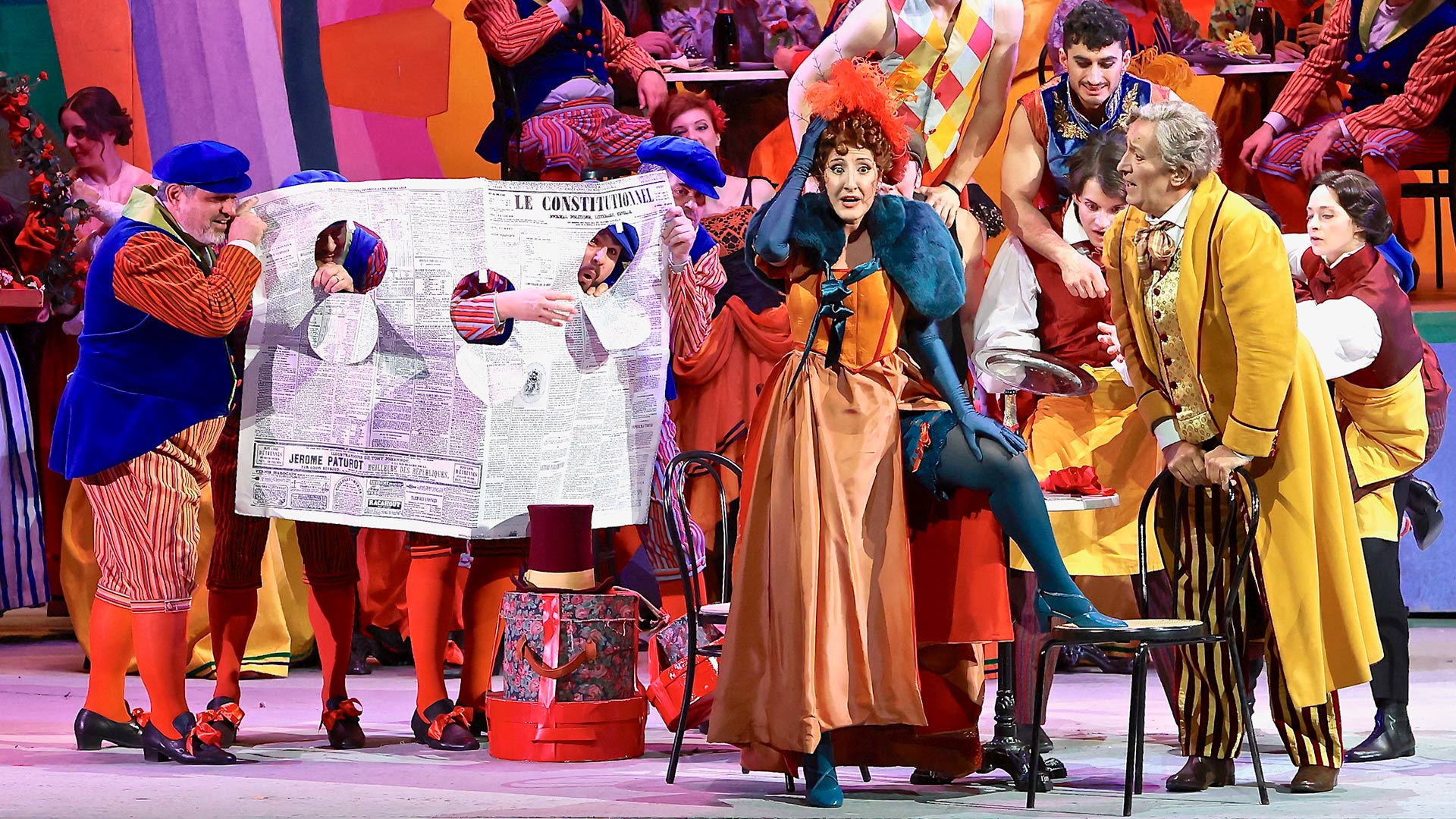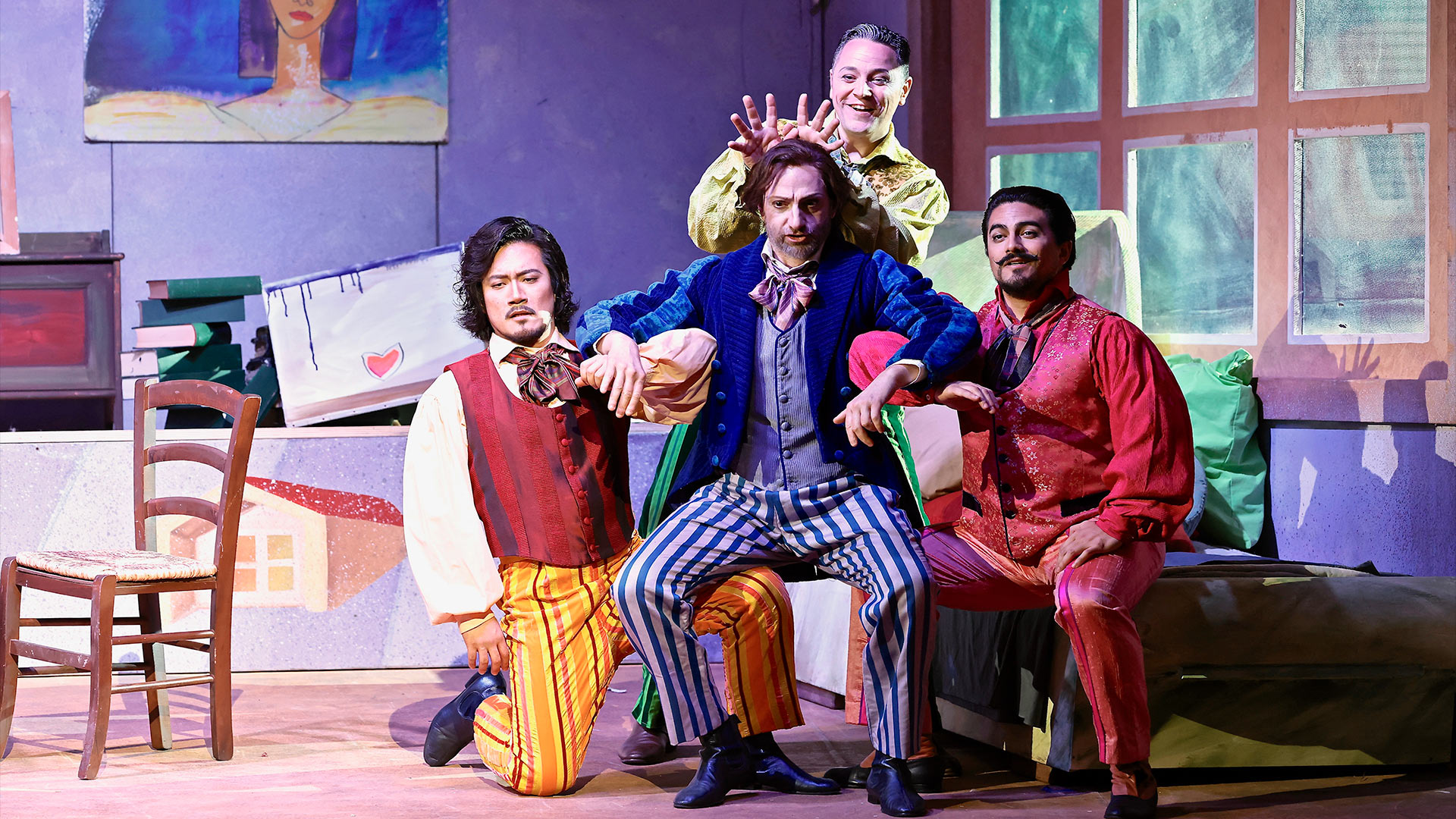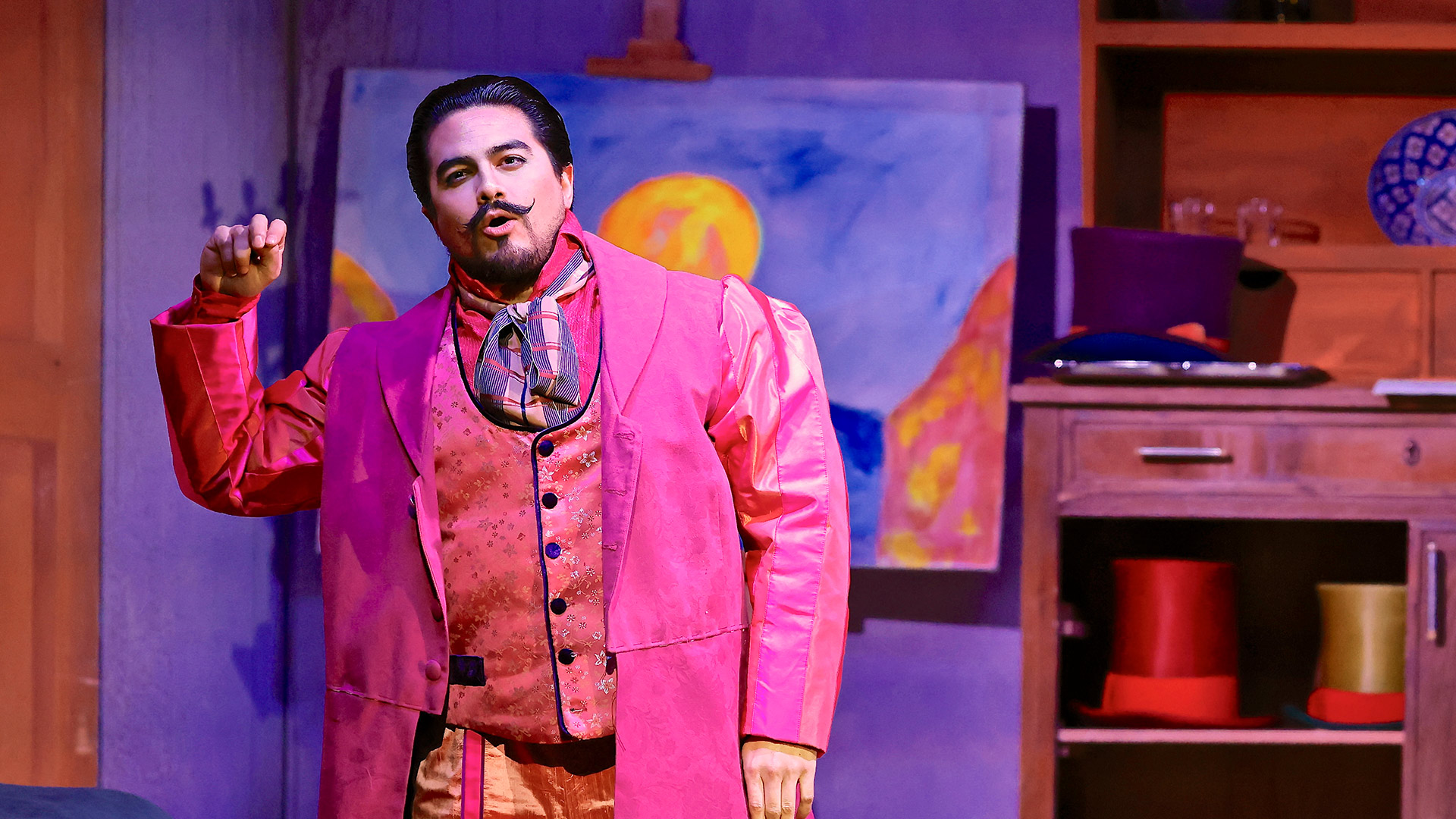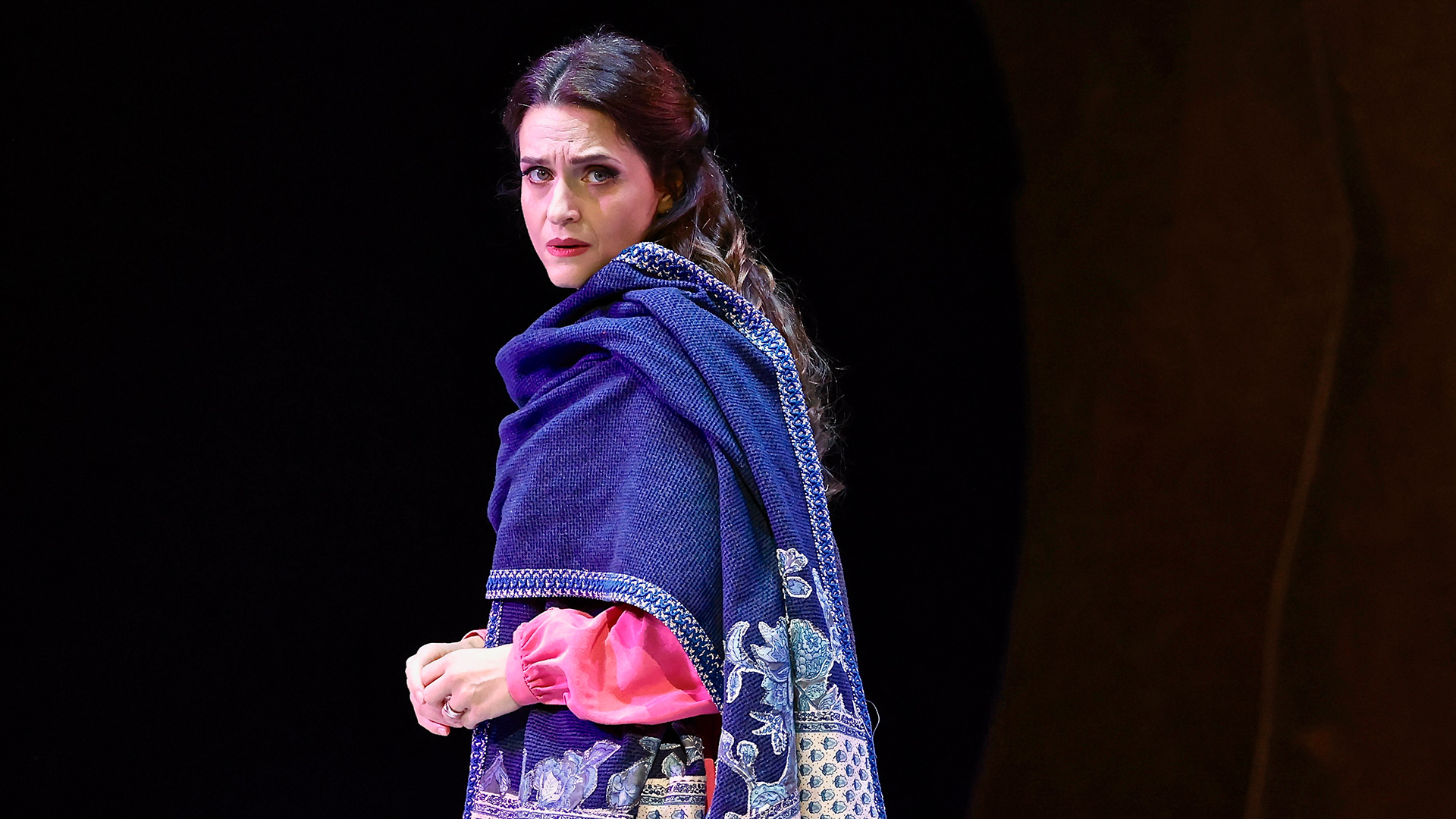Opera scenes in four parts by Giacomo Puccini
libretto by Luigi Illica and Giuseppe Giacosa,
from the novel Scènes de la vie de Bohème by Henri Murger
Characters and interpreters:
Mimì
Anastasia Bartoli
Serena Gamberoni (13, 20)
Rodolfo
Galeano Salas
Alessandro Scotto di Luzio (13, 20)
Marcello
Alessio Arduini
Leon Kim (13, 20)
Musetta
Benedetta Torre
Maria Novella Malfatti (13, 20)
Colline
Gabriele Sagona
Luca Dall’Amico (13, 20)
Schaunard
Pablo Ruiz
Fernando Cisneros (13, 20)
Benoît
Claudio Ottino
Alcindoro
Matteo Peirone
Parpignol
Giampiero De Paoli
Alberto Angeleri (13, 20)
A street vendor
Claudio Isoardi
Antonio Mannarino (13, 20)
Sergeant
Franco Rios Castro
Customs officer
Loris Purpura
Conductor and répétiteur
Francesco Ivan Ciampa
Director
Augusto Fornari
Set and costume design
Francesco Musante
Lighting design
Luciano Novelli
Produced by Fondazione Teatro Carlo Felice di Genova
Orchestra, Choir, Treble Choir and Technicians of Opera Carlo Felice Genova
Choirmaster Claudio Marino Moretti
Treble Choirmaster Tanasini
Staging director
Luciano Novelli
Stage musical director
Andrea Solinas
Répétiteurs
Sirio Restani, Antonella Poli
Stage musical assistants
Andrea Gastaldo, Anna Maria Pascarella
other Choir Master
Patrizia Priarone
Lighting Master
Lorenzo Tomasini
Supertitle Master
Simone Giusto
Children’s Choir Master help
Enrico Grillotti
Head of musical archives
Simone Brizio
Scenic director
Alessandro Pastorino
Vice scenic director
Sumireko Inui
Consolle supervisor
Andrea Musenich
Stage technicians foreman
Gianni Cois
Chief electrician/lighting booth
Marco Gerli
Tooling foreman
Tiziano Baradel
Audio/video foreman
Walter Ivaldi
Head of tailoring, shoemaking, make-up and wigs
Elena Pirino
Director’s assistant
Laura Ruocco
Make-up and hair co-ordinator
Raul Ivaldi
Sets, costumes and props
Fondazione Teatro Carlo Felice
Wigs
Mario Audello
Supertitles by
Fondazione Teatro Carlo Felice
Opera in brief
by Ludovica Gelpi
The genesis of La Bohème began almost as a challenge between two of the most acclaimed opera composers of the late 19th century: Ruggero Leoncavallo and Giacomo Puccini. Both wanted to write an opera based on the novel Scènes de la vie de bohème, by Henri Murger, published in serial form between 1845 and 1848 and finally freed from copyright. Puccini began work on his Bohème in 1893, together with librettists Luigi Illica and Giuseppe Giacosa (with whom he had already worked on his first success, Manon Lescaut). Two years of work on the libretto, divided into four pictures, were followed by about eight months to finalise the score. Puccini’s La bohème was performed on 1 February 1896 at the Teatro Regio in Turin, conducted by a young Arturo Toscanini, and given the enormous success, the opera of the same name by the ‘rival’ Leoncavallo, which premiered in May 1897, was soon forgotten. Puccini later introduced a few variations, so that in the months following the première he arrived at a highly acclaimed final version – the one that is widespread today.
Dramaturgy
One of the most appealing aspects of the Bohème is its setting: Paris in the 1830s, one of the most vibrant and stimulating cities in Europe, with its nascent bohemian culture or subculture, made up of easygoing artists, mostly poor, but united in sharing a dream of aesthetics, ideals and avant-garde. The protagonists of La Bohème embody this lifestyle: Rodolfo is a poet – but he also writes newspaper articles to make ends meet; similarly, the painter Marcello supplements his income by working as a portrait painter in a tavern. Colline, the philosopher, is in a sense a parody of himself, when instead of reflecting on the meaning of existence, he shows up in a huff for the Christmas closing of the pawnshop. The group is completed by a musician, Schaunard, who is not given an equally fine characterisation (in Murger’s novel, the musician is Rodolfo, perhaps Puccini attributed the art of poetry to his protagonist to ward off autobiographical interpretations of the opera). The two female characters are antithetical, and they in turn know the hardships of a poor life: Mimì lives alone in an attic, next to bohemians, and embroiders flowers; Musetta leads a dissolute life, going from one wealthy lover to another (her most sincere love is Marcello). Alongside them, a diverse and multifaceted human cast of students, bourgeoisie, shopkeepers, street vendors, waiters and seamstresses bustle through the streets of Paris. The only antagonist is the ominous omen that haunts the protagonists: disillusionment, the subtle and ill-concealed awareness that art and ideals will not save them. Relationships – fraternal friendships, overwhelming and complicated loves – are depicted in their moving complexity and in a tireless alternation between the dimension of playfulness and carefreeness and the dimension of despair. Mimì and Rodolfo fall in love as two young boys might fall in love, but from the start her illness looms large, and both can only pretend their happiness, until the ending falls apart in their hands. Marcello and Musetta give in to passion, aware from the first moment of their deep incompatibility and of the imminent and painful end. The union of the four friends is based on goliardia, all of them taking part in a play, for themselves and for others, in order to hide the most lacerating and unconfessed fear: will the world leave them marginalised forever? One of the most emblematic moments of the contrast between the two dimensions is the finale of the third painting, when Mimì and Rodolfo openly confront their relationship problems. They know that their story has come to an end and once again they pretend: leaving in winter is cruel, ‘We will leave each other in the season of flowers’.
Music
A singular example of Puccini’s innate melodic talent, La bohème is a title that encompasses diverse musical influences, from melodrama to German romanticism, from Wagner to the late Verdi, and from opéra-lyrique to salon romance. The rich amalgam of timbres, rhythms, dynamics and colours is skilfully employed to recreate in music the setting of the opera in all its details, according to a meticulous descriptivism that explores both environmental and psychological aspects. The relationship between the music and the sung text is one of total symbiosis, the melodic lines take shape with the words, and vice versa (this makes it even clearer why the libretto was so long in the making, and of course the winning synergy between Puccini, Illica and Giacosa). The dramaturgical and musical homogeneity in the psychological representation of everyday life reaches a level of great innovation in the Bohème, especially considering the Italian panorama at the end of the 19th century. No division into scenes punctuates the action, the musical discourse flows seamlessly from the beginning to the end of each picture, outlining four unique scenes that are almost autonomous and complete in the narrative. Nevertheless, the musical discourse remains cohesive. Fundamental in this respect is the complex weave of recurring motifs, veritable Leitmotifs, symbolising elements, characters and affections, to the point of suggesting to the listener what is not said or represented (thus the motif of Bohemian life, the motif of Mimì and Rodolfo, the motif of the festive evening at the Café Momus, among others, are present). Linked to this aspect is an element that will return in several works of the composer’s maturity, namely ‘reminiscence’, explicit in the dialogue between Mimì and Rodolfo: ‘Are they gone? I was pretending to be asleep’. In the last moment of Mimì’s life, the two lovers recall the moments they spent together, the ‘dramaturgical’ memory is joined by the musical one, thus returning in the orchestral part and in the vocal lines the central themes of their story, in particular ‘Sì, mi chiamano Mimì’ and ‘Che gelida manina’, with subtle variations in tone and mode to signal the painful combination of affection: sweetness and despair.
Three whims
by Michele Mari
The large fireplace, extinguished
The great fireplace, extinguished, lived in idleness like a great lord. He thought with gratitude of the vast, distant forests, which had not given him his tribute for a long time: stupid forests, as if having to take out logs of wood was not a nuisance for him. He was much better off this way, in the freezing cold, without having to worry about that pathetic ritual of flames and embers, where the man, he had heard without understanding it, where the man is faggot and the woman is winged. Lately, however, some jerk had thought of sacrificing a chair to him, and another had even thrown four acts of a play into his jaws: not to mention the painter who was about to throw in one of his horrible crusts entitled The Red Sea. Then came the unforeseeable outrage: a man named Schaunard had delivered firewood to the strikers, who, instead of taking comfort in a nice fire, decided to go out to dine at a restaurant, induced, paradoxically, by their own rescuer (‘Dining at home / on Christmas Eve / while the Latin Quarter decorates its streets / with sausages and delicacies? ‘): not before, however, a surreal figure had appeared in their speeches: an oak-woman (a cannon: I don’t mean a whale or a globe).
What does our chimney see, then? He sees the poet pause to conclude an article that he will not conclude, and thus witnesses a dance of three lamps, two in the room and one outside: of the two, one is extinguished by the poet out of economy, while the one outside is extinguished by a breeze: Having rushed to relight it by means of the surviving lamp, the poet will also extinguish the latter by his own movement: room and landing thus remain in darkness, where a key dropped on the floor is hidden, a key which, having been found, will pretend not to be found, to the amusement of the great chimney that studies humans and their clumsy subterfuges. The poet is poor, of course, but when it comes to rhymes, he revels in them like a grand lord: indeed, he has a millionaire’s soul, so much so that ‘sometimes from his treasure chest / they steal all the jewels / two thieves: the beautiful eyes’. The darkness authorises the idea that the owner of the key has precisely such eyes, although, immediately, the chimney takes note of suspicious elements: she lives on flowers and among flowers, but those flowers are false; she is called Lucia but is called Mimì, and she cannot say why…
Go now, to the Latin Quarter! And Rhine wines and salami and roast venison and turkey, and lobsters, and oranges, dates, plums, chestnuts, carrots, and coconut milk and whipped cream, candies, nougats, tarts, and then trinkets, bonnets, coral veins, crosses, pins, and again: jackets, horns, pipes, then: chaffinches, sparrows, flowers, and also: little horses, whips, cannons, trumpets, drums and tambourines, and finally: a very rare runic grammar. ..
After the orgy, a leap forward: Mimì is repudiated by the poet, who pretends to be jealous: in reality, the fault lies with the fireplace, which, as big as it is empty and cold, cannot melt the chill of death that undermines the maiden: ‘My room is a den / squalid… the fire I have put out. The wind / of the north wind enters it and goes around it’. In the desolation, notes the blameless chimney, humanity gives way to things: a headband, a prayer book, an apron and a bonnet, this is Mimi; a pen (‘infamous’), a paintbrush (equally ‘infamous’), this are the poet and the painter; and a herring (‘Choose, o baron: / trout or salmon?’) remains a herring, water (‘Or lo sciampagna’) remains water. Three objects remain imprinted in the spectator’s mind: a sleeve, a fantastic rescue, an old zimarra committed to the Monte di Pietà, and a chair, one of the few not sacrificed at the fireplace, which for a moment, perhaps, moves him.
Chair waltz
I am the first chair, on the verge of being sacrificed to the flames: I am saved, unexpectedly, by a poetic text by an aspiring poet named Rodolfo, a text, it turns out, that must have been very bad. Shortly afterwards, I run the risk again, as it periodically happens to us vile items of furnitur
I am the second chair: I am offered to a certain Benoît and gladly bear the burden.
I am the third chair: in front of a shop the salesman climbs on top of me to glorify his wares.
We are other chairs: under the orders of three figures called Colline, Schaunard and Marcello, a waiter takes us into the Momus dehors.
I am the fourth chair: seeing the fatal Musetta coming, Marcello collapses on top of me.
I am the fifth chair, at the neighbouring table in the same dehors: Musetta imposes a ridiculous tome on me, Alcindoro.
I am always the fourth chair, on which Marcello, seething with jealousy for Musetta, wants to be tied, the fool!
I am the sixth chair, prepared to receive Alcindoro, who upon discovering that he has to pay the bill for everyone collapses on top of me, unceremoniously.
I am again the first chair, or perhaps the second: Schaunard climbs on top of me with his shoes in a lather to toast theatrically, but luckily for me he is immediately brought down.
I am a bench, in the cabaret where Rodolfo fell asleep.
I am the seventh chair, but because of my slender shape they call me scranna: it is on me that Rodolfo sits next to his dying beauty, whom they tell me is called Mimì.
I am always the first chair, or perhaps always the second: Rodolfo climbs on top of me to shield the dormer light with a mantilla.
I am a chair, no matter what (in fact, we could say: the chair): on me, dead Mimì, Schaunard collapses, and everything comes to an end.
What about us? We are the stuffed chairs of the theatre, we are many, many, and throughout the show each of us has supported an amused, bored, passionate, distracted, competent, incompetent, delighted, irritated, moved spectator: as the terga, without possibility of error, reveal.
Eros of Musetta
Mewsette does not have a face, she has a muzzle (however pretty): she is therefore a beast. Fascinating, but a beast; fascinating as a beast.
His heart, heads Marcello, is not a heart: it is a big icebox.
Marcello again: “By his vocation / he makes the wind rose; he turns and changes often / and of lovers and of love. / And like the owl / he is a bloodthirsty bird; / his ordinary food / is the heart… It eats the heart!” And after calling her an owl three more times, not satisfied, he epithets her as a viper, then as a witch.
This would be enough to make her a sadistic dominatrix, a hidden dream of many. But Messrs Illica and Giacosa wanted to go even further, and so here is the opera’s most memorable scene, the triumph of fetish a century before the category was defined:
Musetta (feigning severe pain in one foot, goes to sit down again) – Ahi!
Alcindoro – What?
Musetta – What pain, what burning!
Alcindoro – Where? (bends down to untie Mewsette’s shoe)
Musetta (showing her foot coquettishly) – Al piè!
Untie, untie, tear!
I implore you…
Over there is a shoemaker.
Run quickly!
I want a couple more.
Ouch! what a pang,
damn narrow shoe!
Now I take it off… (she takes off his shoe and places it on the table)
Here it is.
Against this ankle, against this coquettish foot, what can Mimi’s icy little hand do? Nothing, one would say. But art (art!), the beauty that so sublimates us, dissents, and forces us to answer: everything.
